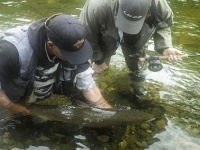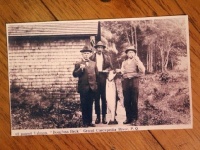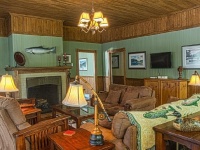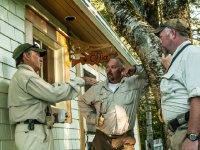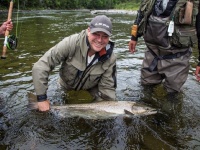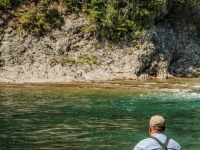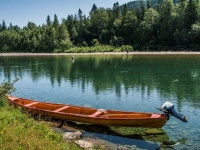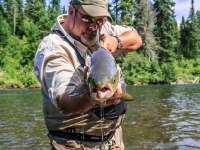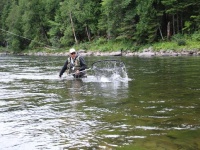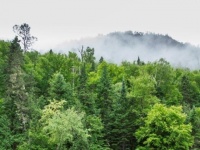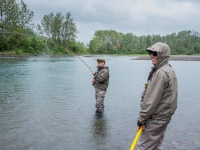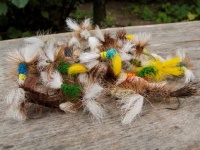The Gaspé region of the eastern Canadian
province of Québec has long been known for its magnificent ocean vistas sweeping along an extensive coastline and, inland, beautiful pine-clad mountains. It is also world-famous for its magnificent wilderness rivers and outstanding salmon fishing. The wild Atlantic salmon has long been considered the king of freshwater game fish – the ultimate quarry for the fly angler. And there is perhaps no finer angling water on the planet in which to fish for them than the Gaspe region of Québec.
The Gaspé Peninsula is located at the eastern end of the French-speaking Canadian
province of Québec. Slightly larger than Belgium, at 31,075 square kilometers, it juts out into the North Atlantic Ocean at the Gulf of St. Lawrence and is surrounded on three sides by the sea. Into that great cold ocean are several wild, untamed rivers flowing out of the beautiful Chic Choc Mountains, the northernmost point of the ancient Appalachian Mountain Range. These magnificent wilderness rivers are home to unique tribes of wild, indigenous Atlantic salmon which have been here since the last ice age.
In the south coast of the peninsula, along the lovely
Bay of Chaleur, lie three of the most exquisite rivers you will ever see. The enchanting, emerald green-coloured Bonaventure and Petite Cascapédia and the gold-tinged Grand Cascapédia will take your breath away. The clarity of the water is astonishing. It is without a doubt the best place in the world to sight-cast to large Atlantic salmon using dry flies (which they will readily take when they’re in the mood).
Fly fishing for salmon in these river valleys has a long and noble tradition that goes back over 150 years. And for most of that time these special rivers were the exclusive private domains of
North America’s rich and powerful. But in the last few decades these exclusive rivers have been opened up for the traveling angler. And for die-hard fly fishers, it’s as close to heaven as you’ll likely find on earth.
Accessing the water in this region of the
province of Québec can be a pretty complicated affair. All rivers require a daily access pass. The cost varies by location from a few dollars to several hundred depending on the quality of the beats and the dates. Rivers are divided into zones and then further sub-divided into specific beats. Most often two anglers will have their pools to themselves but on some stretches there may be several rods. Each river has its own management authority that sells access passes and manages the various beats. A pre-season lottery system is also used to reserve specific, coveted beats as well as daily and weekly reservations for available water during the season. Frankly, although the whole system works well in terms of salmon management, it can be quite difficult for the visiting angler to navigate on their own. The best beats and dates are also hard to know and even harder to obtain.
That’s part of the beauty of fishing at Camp Bonaventure and Salmon Lodge – you don’t have to worry about any of that! It’s all taken care of. Camp managers Glenn LeGrand and Junior St. Onge know the rivers top-to-bottom and are able to secure the best beats at the best times for their guests, often well in advance of the season. And if conditions change they are also able to quickly adjust plans, often securing exclusive beats. For guests of Salmon Lodge and Camp Bonaventure it’s effortless. All you have to do is wander into the wader room after breakfast, glance at the chalkboard to see where you’ll be fishing that day and with which of their outstanding guides you’ll be fishing. That’s it. Slip on your waders, grab you fly rod and a fresh cup of coffee for the road, and off you go. Confident in the knowledge that you are about to fish some of the most stunning and productive wild Atlantic salmon waters in the world.
The Lodges
The quality of the accommodation, food, service, guides and fishing are simply outstanding at both lodges.
Camp Bonaventure and Salmon Lodge are the only Orvis endorsed Salmon fishing lodges in Québec and two of only a handful in Canada. In recognition of their excellence, Camp Bonaventure was awarded the 2013 Orvis Endorsed Lodge of the year award and Salmon Lodge was an honourable mention. Packages include all lodging, meals, fishing and guides with three, four and seven day packages available at both Camp Bonaventure and Salmon Lodge. All necessary fly-fishing equipment including rods, reels, boots and waders are also available if needed. For beginners, all the guides are certified fly casting instructors and great teachers. Both lodges have well-appointed rod rooms with individual locker areas and rod racks for anglers to store their waders, rods and gear as well as a small but well stocked pro-shop.
It’s the little things that really put these twin camps over the top. No detail is too small to be considered and each thoughtful touch enriches the whole experience. There are hundreds of little flourishes, large and small, throughout both camps with a distinct fishing and sporting theme. Works of salmon art adorn the walls and leaping salmon silhouettes look down from high perch on the veranda gables.
In the rod room you'll always find fresh coffee in the morning and cold lemonade in the afternoon when you return from the day’s angling. And at bedtime, a gracious, hand-written card on your pillow gives the weather forecast so you can properly adjust the scene of the coming day in your mind as you drift off to gentle dreamland in a big comfy bed you wish you could bring home with you.
Camp
Bonaventure
Nestled in a natural stand of northern white birch on the banks of the beautiful
Bonaventure River, Camp Bonaventure is truly one of the world’s great fishing lodges. Built in1993 and run to exceedingly high standards by camp manager Glenn LeGrand and his business partners, the lodge quickly gained an international reputation for excellence and an equally international clientele. This luxurious camp draws discriminating anglers from around the world to test their skill against the mighty Atlantic salmon.
The main lodge features sumptuous bedrooms with private bathrooms and screened in sitting areas, a large and comfortable dining room overlooking the Bonaventure river and a huge living room, featuring a thirty five foot stone fireplace. In the living room is a fully equipped fly-tying desk where guest can sit down and tie up the perfect fly for the next day’s adventure.
A short walk from the main lodge is a private guest house, featuring two bedrooms with private bathrooms and screened porches. A private living room with a huge fireplace completes this wonderful setting. It's an ideal place for a gathering of close friends or a small business group. The large outdoor deck is always a popular gathering place for morning coffee and drinks in the evening, where the day’s fishing stories are told in a setting so sublime that new friendships could not help but flourish and old ones be reaffirmed.
Complementing the wonderful surroundings are fine meals served in a spacious and well-appointed dining room, over-looking the river. Huge BBQ T-bone steaks, prime rib roast and fresh Atlantic lobster with melted butter and fresh bread are just some of the culinary delights that are presented to guests each evening, followed by mouth-watering homemade desserts. Once the final coffee refill has been poured and the last slice of cake has been served, the staff at the lodge seem to just magically melt away, leaving the entire lodge to the guests and making it feel that much more like your own private retreat to enjoy and savour. Fine dining, superb accommodations and great service are all hallmarks of the
Camp Bonaventure experience.
Click here to see more photos from Camp Bonaventure
Salmon Lodge
Salmon Lodge is a grand old lodge in the classic style, with a sweeping panoramic view of the storied
Grand Cascapédia River at its feet. Its architecture speaks to its age – or rather, to the age in which it was born – at the turn of the last century. A period in history when North America’s business titans and political elites first discovered the magic of the rivers and were smitten. Building magnificent lodges in the wooded valleys of faraway eastern Canadian rivers, they were to bask in the halcyon days of fly-fishing’s early history on this continent.
Salmon Lodge was built in 1901 by Benjamin Douglass Jr., a wealthy corporate lawyer from
New York City and was originally called Camp Douglass-Beck. Douglass clearly had an eye for real estate, choosing to situate his camp high up on an east side bluff overlooking Trout Brook Pool. This perch provided a commanding, 180 degree view of the Grand Cascapédia River below. In fact it is generally agreed that the view from the back deck of Salmon Lodge is the best in the whole of the Cascapédia Valley.
The lodge changed hands several times over the next century until in 2005 it was acquired by Glenn LeGrand and his business partners at nearby
Camp Bonaventure who renovated it extensively and opened it up as a high-end, full-service lodge. “Our goal was to bring Salmon Lodge up the high standards we had set with our other operation at Camp Bonaventure while still respecting the history and heritage of this special place” says camp manager LeGrand, “and I think we did that.”
Salmon Lodge features spacious and elegant bedrooms with full private bathrooms and stunning river views, a massive wrap-around deck overlooking the river valley and a separate guesthouse nearby. Like its twin lodge,
Camp Bonaventure, dinning at Salmon lodge is superb. In the morning hearty breakfasts are served featuring fresh fruit, free range eggs and local sausages and homemade wild berry jams, local maple syrup and fresh breads baked daily. In the evening the chef’s menu boasts fresh local seafood including local Atlantic lobster, prime beef and many other mouth-watering creations to temp the pallet of even the most discerning gourmand.
Visiting Salmon Lodge is a deeply authentic experience. A window into a golden age of angling and a glimpse into the heart of our sporting tradition. Rich in history, it is at once both as elegant as a ballroom and as comfortable as favourite old sweater. It is, in every sense of the word, a true sporting classic – the real deal. And it’s also one of the few such historic salmon fishing lodges still in existence that is open and available to itinerant anglers. The lodge is magnificent, the meals are superb and that sweeping panoramic view from the back deck just never gets old.
Click here to see more photos from Salmon Lodge
The Guides
As you would expect of an Orvis endorsed lodge, the guides at
Camp Bonaventure and Salmon Lodge are top-notch professionals who love what they do, work hard to get you into fish and literally attend to your every need. They are also bloody good companions on the water. They know the rivers and where the fish will be in all water levels. They know all the best taking spots and how the fish like to see the fly presented and they watch every drift like a hawk.
Each morning the camp guides gather outside the lodge well before their sports are finished breakfast, ready and raring to go just as soon as you are. They huddle over coffee and discuss which pools are fishing best, flies that are working and other tactical matters. Then it’s off to the races as you drive up the charming river valleys en route to the waters you will fish that day, confident that you are in exceedingly good hands.
And when lunchtime rolls around, out comes a riverside feast fit for a king, featuring hot stews, porridge bread, pickles, cold cuts and cheese. There’s wine with the meal and hot coffee with desert. All served on a fold-up table complete white tablecloth and napkins. The finest of dining in the great outdoors. These guys have everything covered.
The Season
The first salmon to arrive are mostly large females, which start showing up by late May, building throughout June followed by a mix of salmon and grilse in July. The runs just build from there, through August and September, when the rivers pools are full of salmon. In the early season the salmon are often accompanied by pods of silvery, sea-run brook trout that quickly race up the river and into the headwaters. Here today and gone tomorrow, these beautifully colored native char can grow to over five pounds and are a pleasant addition to early-run salmon fishing. Resident brook trout can also be angled throughout the season.
Salmon numbers in the river fluctuate with each raise of water, ascending the river at a more leisurely pace than their brook trout cousins. New fish will arrive with each new tide and raise of water, while others move steadily upriver toward the headwaters. By early June, you can be sure that there will be fish in the river. You just have to find them and show them the right fly.
There are two’ prime time” fishing periods, although good fishing can be had anytime during the season. The first prime time period runs from June 10th to July 15th and the second from August 15th until September 25th. Both periods provide excellent fishing but are very different and special in their own way. Fishing in June and early July is a combination of canoe fishing, using traditional 26 foot river canoes and wading with most hookups coming from swinging wet flies. The August and September period, is mostly wade fishing, sight-casting dry flies to visible salmon.
In the early season, from June first to mid July wet flies are the order of the day, as the water is quite cold and the fish are less likely to take dries. As July turns into August, the reverse is true. Although salmon will still take wet flies it is clear that their preference turns to flies that float upon the surface. And there is nothing else in the angling world quite like the rise of a large, wild Atlantic salmon to a dry fly in crystal clear water. It is one of the peaks of the sport. Like sipping 50 year old single-malt scotch. It’s that good.
The Rivers
The Bonaventure
The
Bonaventure River is over 100 kilometers long and flows in a distinct north-to-south direction, emptying into the lovely Bay of Chaleur at the small town of the same name. Like all of the rivers of Gaspé Peninsula, the Bonaventure descends from the high Chic Choc mountains, cold and clear, with a distinct emerald tinge of colour that is almost otherworldly. And the clarity of the water is truly remarkable. Underwater visibility can exceed 150 hundred feet. And the surrounding mountains, covered in a blanket of towering coniferous forest, provides a stunning backdrop. I’ve been fortunate enough to fish a lot of rivers in many places over the years but I must confess that the Bonaventure may be the prettiest I have ever seen.
We crossed the river well below the main pool, at the lower of two crossing spots at the well-named Double-Crossing Pool. It was just after lunch and the sun was high in the azure sky. Our eagle-eyed guide, the outstanding Clement Bernier, instructed us to walk slowly and carefully up the right hand bank. He was counting fish as we went. By the time we reached the head of the pool he had already spotted over a dozen salmon. Then we saw the mother lode, holding just below the white water where the river tumbles into the head of the pool. A pod of at least 30 large salmon along with a few grilse, holding in the crystal clear water. It was a breathtaking sight. “You need to approach them very carefully” said Clement. “If you can see them, then they can see you too. So you need to move quietly.” He instructed us to approach the group slowly from below. A sunken log on our side of the river provided a bit of cover for our boots as we waded into position.
Up first, my long-time fishing companion and outstanding southpaw angler, Gerry “Deep Water” Doucet who began tossing delicious looking drag-free drifts over the pod using a large, white-winged bomber-style dry fly that Clement had tied the night before. As the fly dropped at the top of incoming run and bobbled along into the head of the pool a large fish made a huge head and tail rise but refused to open its mouth and actually take the fly. This behaviour is common among Atlantic salmon in the summer when the water temperature gets above 60 degrees Fahrenheit. Often a salmon will rise several times to a well-presented dry fly before taking it – or not. For an angler, raising a large salmon presents the penultimate moment. Gerry waited as long as he could stand and then cast the fly again.
Watching intently from the branches of a nearby tree Clement said “He move for it. Wait a minute and try him again”. Gerry repeated the cast and put the fly right on the button. But before it reached the big fish’s lie a smaller salmon of around 8 pounds grabbed the fly and took off across the pool. Zing – the line cut through the water as the fish took to the air in a glorious leap for freedom. Gerry bowed his rod to the fish and the fly held solid. After a few more runs and jumps the fish began to tire and was soon brought to Clement’s waiting net. She was a lovey silver rocket and although disappointed to have missed the bigger fish, Gerry was still thrilled to land and safely release her back into the lovely jade-coloured river.
After resting the pool for a half hour while casting to a few fish holding in the thin, spooky water at the tail of the pool, it was now my turn to have a go at the big pod of fish at head of pool. Clement tied on a #2 blue-bodied dry fly called the “Labatt Blue”. I waded out into position and began casting. It’s heart pounding stuff this; sight-casting dry flies to big salmon in crystal clear water. And there is nowhere on earth better to experience sight fishing for salmon than the beautiful Bonaventure River. In my opinion it’s something every angler should experience at least several dozen times before shuffling off to that great home pool in the sky. On most salmon rivers you watch the fly. On the Bonaventure you watch the fish!
After five minutes of casting I rose a huge cock salmon (personal record territory). He came up well after the fly had already drifted over his lie for the umpteenth time and came charging directly downstream towards me, following my bomber a dozen feet before finally grabbing it. But when I struck… there was nothing but air!!! The hook had pulled straight through the hole created by the fish’s massive kype as he turned. My fly had failed to make contact. Our guide Clement exclaimed “if that fish wasn’t 30 pounds he had to be some close”. I exclaimed a few choice words myself. But try as I might, no subsequent drift made with shaking hands and pounding heart could coax that big boy back up again. Having crushed and drown my fly he was apparently quite satisfied that he had killed the little floating interloper and would move no more. Eventually a nice 10 pound fish came up from the bottom and sucked my bomber down as casually as a brown trout sipping a may fly. This time there was no mistake as the hook found purchase and a chrome-bright fish came rocketing out of the water in a spectacular, twisting leap. When he hit the water he was off and away on a long run down to the tail of the pool. We followed the fish and due course he was landed and safely released. “I like the way you guys drive ‘de fish to ‘de net” said, Clement in his distinct French Canadian accent.
Later in the afternoon we took a nice walk downstream to a lovely roily run without a name. Not a proper pool, it was one of a collection of “top secret spots” on the river Clement liked to take his clients to. “When the fish are there it’s great taking water” he assured us. And sure enough, over the next two hours we hooked two, lost one and landed one salmon each as the setting sun cast it’s warm, lovely light all around us. It was magical. The perfect end to a perfect day on the beautiful
Bonaventure River.
The Grand Cascapédia
The Grand Cascapédia is, quite rightly, one of the most famous fishing rivers in
North America. Princess Louise Caroline Alberta, the fourth daughter of Queen Victoria and Prince Albert, built an expansive retreat on the river in 1880. And ever since then The Grand Cascapédia has played host to world leaders, the rich and the famous. As its name suggests (the French word “grand” meaning big or large), at 140 kilometres long and with two substantial headwater branches, the Grand Cascapédia is the largest river in the region. And its name could also be used to describe its fish – which run big… very big.
It is a well known fact that each salmon river is home to its own unique family or “tribe” of salmon which often display their own unique genetic characteristics. One of those is size. And on this river they can grow to record-breaking proportions with fish of over 50 and even 60 pounds taken in historic and even modern times. 30 plus pound fish are not at all uncommon here although there are also lots of smaller year classes. Unlike their 5 pacific cousins, Atlantic salmon don’t die after spawning and will return to the sea, grow larger and then return to spawn a second or even third time. The really big fish are most likely repeat –spawners and knowing that with every cast you have the chance at a legitimate trophy specimen makes the experience all the more thrilling.
Unlike the green tinge of the Petit and the Bonaventure, the water of the Grand Cascapédia is darker, with a distinct tea-stain colour in high water, clearing to an almost golden hue in low water. The majestic
Chic Choc Mountains frame its length with the verdant green of the Canadian boreal forest. It is truly a magical setting in which to angle for the noble Atlantic salmon.
Low-hanging clouds drift slowly up the valley as we emerge from the trail to Upper Murdock Pool. Gently brushing the tree tops, these ghost-like shapes are atmospheric remnants from a series of thundershowers that had come rumbling through the valley overnight, leaving the forest wet and glistening from fresh rain. As we had hoped, the thundershowers had brought the water level up by about six inches. This, we reasoned, would excite the fish and hopefully increase our chance of a hook-up. Today I’m fishing with two guides: Rejean Cyr and Kris Jerome who know this river well.
I wade out a few feet into the river and pause to take in my surroundings. A big bald eagle is perched on the top of a towering old pine on the bank across from me. As we both watch the pool, a good sized fish leaps clear of the water - way out in the middle of the pool. The fish lands on its side with ponderous authority and shatters the stillness of the pool. The eagle spreads his wings and swoops down to take a closer look before circling back up to his perch. He looks at me as if to say “Nope, too big for me, are you going to give him a try?”
I pull out thirty feet of line and begin working my way up the pool from below, tossing a big buoyant bomber-style fly called the Carters Bug here and there along promising looking seams and across glassy looking slicks. I’m probing the pool, searching for a taker who will rise up through the swift current and take my surface offering. As I approach the spot where the big fish jumped, a silver-blue back appeared beside my bobbling dry fly. I saw the fish and knew he didn’t take the fly and so I resisted the automatic urge to pull it way and potentially spook the fish. Instead I waited for a few minutes and then tried the lie again. But several more drifts over the same spot resulted in nothing. “He’s our further toward the other side” said Rejan. “When he showed to the fly I think he swam quite a ways over from the left. Try it a foot higher up and a foot further out.” I popped it out again but was still a bit shy. “A little higher up and a little further out” he repeated. So I pulled two extra feet of line off my real, lifted the bomber from the surface, made one false cast to measure the extra distance and then let the big dry fly flutter down to the surface of the moving water. Whamo! Three second after the fly lands a big head came up and takes it down just as pretty as you please. I set the hook, the line comes tight and the fish goes ballistic.
Quickly he’s peeling out line and into my backing as he races downstream towards the skinny water at the tail of the pool. My heart skips a beat as I see a large salmon leap across the surface, dragging my submerged line sideways as he hits the water. I bow the rod to the fish but the line goes slack and I think I’ve lost him. But then he jumps again, closer this time and I realize the fish is running upstream now and the fly, thank god, is still attached. Reeling fast, I get the fish back on the rod just as he passes me and keeps right on going up to the head of the pool where he makes another high, twisting leap. Luckily the hook holds and so does the fish. He dogs me there in the deep water for several minutes until I feel his energy begin to wane. After a few more head shakes and another couple of short runs, I turn the fish and bring it quickly to Rejean’s waiting net.
Without taking it from the water, Rejean removes my winning bomber from the corner of the fishes’ jaw and after quick photo I take the great fish by the tail and turn it into the current. Supporting her – it turns out to be a nickel-bright, 25 pound hen – I can feel her strength return as she began to catch her breath. After a few minutes she gives me a couple of strong kicks with her tail, signalling that she is ready to go. On the next good kick I oblige and watch as she swims briskly back into the depths of the pool. Standing waist-deep in the water I smile and shake hands with Rejean and Kris and just savour the moment. Looking out over this magnificent pool in this magnificent place, I am exalted. It simply does not get any better than this.
The Petite Cascapédia
As its name suggests, the “Petite” is a smaller river located nearby to the much larger “Grand” Cascapédia. Although it’s only half the size, don’t let the name fool you. Like its big sister, the Petite can produce some very large salmon in the 20 to 30 and even 40 pound range and is also home to a distinct population of large, sea-run brook trout. Percolating up from a thousand cold-water springs, the river is always surprisingly cold, even in the dog days of summer. Perhaps because of the cold, well-oxygenated water, the salmon on the Petite have a reputation for aggressive strikes and spectacular battles. Like the Bonaventure, the Petite Cascapédia’s water is very clear with a distinct tinge of green.
This morning I am fishing with a new companion, Arnold Mai who hails from
Irrel, Germany, near Luxembourg. Arnold has brought with him across the Atlantic Ocean two treasured pieces of antique fishing gear. A beautiful old Walker-Brampton split-cane rod and a WWII-vintage Hardy Perfect 3 3/4 inch reel, both inherited from his father. He said it was his fondest wish to hook his first Atlantic salmon on a dry fly using this special rod and reel. “Well” I think to myself, “you have certainly come to the right place at the right time to make that dream a reality”. We are at Edgar Cyr Pool and it is mid-morning on a grey, overcast day – the kind of day that just feels “fishy”. And sure enough - every now and then we spot the silver back of a “rolling” fish breaking water or “porpoising”. A very good sign of active fish.
Arnold goes through the pool first, casting a large white-winged bomber fly with a pale olive deer hair body. But no luck. I follow down behind him with a small John Olin wet fly – with the same result. No takers. We contemplate changing pools but our guide, young Charles Binnett, feels we should stay and give the pool another pass. “If you look up at the run above the head of the pool you can see the odd fish breaking water” he said. “I’m pretty sure we can get one of those fish if we stick with it”. Thus fortified with renewed confidence we walked back up to the head of the pool. But this time we decided to start 30 feet higher up in order to fish the fast water running into the head of the pool. Charles suggests switching flies and hands
Arnold a smaller brown bomber with a single deer hair wing. Casting with big long strokes Arnold rolls out a beautiful line with his antique bamboo rod. And sure enough, after several casts a nice fish bolts up at the lip of the run and the little dry fly is gone.
Arnold slowly lifts the ancient rod and the fish goes aerial, making two nice jumps in a row. It is no wonder the ancient Greeks named it Salmo Salar – the leaper. Once hooked, these fish certainly love to spend time in the air. Then he’s off on a tear down into the main pool, where he holds just long enough for
Arnold to follow down and tighten up on him then he’s off again, in big spray of water. And this time he just keeps going, barely pausing at the tail of the pool before leaving it entirely and continuing downstream into the boulder-strewn fast water.
Charles has to get into position well below the fish and
Arnold is eventually able to swing the fish it into position for Charles to scoop him up in a small back eddy. Whew! What a battle! And as you can imagine Arnold is one very happy camper. “I came here for the first time and I was hoping to catch a salmon on a dry fly on this wonderful old fishing tackle” he said. “And it actually happened. It is like a dream come true.” Then he added “I think I will have to come back again soon.” “Yes” I agree. “That would be a very good idea”.
Tackle
Single handed rods of 9 to 10 feet are generally used along with double-hand spey and switch rods from 10 to 14 feet long. Regardless of the size of their rod, anglers are well advised to have a good reel with a good drag system and at least 200 yards of backing in case they tie into a big fish – which is not at all uncommon here. Floating lines in #8 and #9 weights are used throughout the season with intermediate sink tips generally only occasionally used in the early part of the season if the water is high and cold. Unlike bottom-hugging winter steelhead, these Atlantics are quite surface-conscious. If they want your fly, they will take it. And they will rise from surprising depths to do so. Leaders are generally 9 to 12 feet long with a 10 or 12 pound tippet. Many anglers here swear by the practice of matching the colour of their leader with the colour tint of the rivers they are fishing. This means carrying clear leaders as well as green and brown coloured versions to match the colour cast of the water.
Favourite Flies
Wet: Picasse, John Olin, Rusty Rat, Blue Charm, Green Highlander, Undertaker, Silver Rat and various stonefly patterns such as the Stone Ghost.
Dry: Spun deer-hair Bomber-style flies in every size shape and colour imaginable. Often tied with white wings and tails in green, brown and blue.
More Info
For more on fishing at
Camp Bonaventure and Salmon Lodge or to book a trip:
www.campbonaventure.com
www.thesalmonlodge.com
1-800-737-2740
418-534-3678








